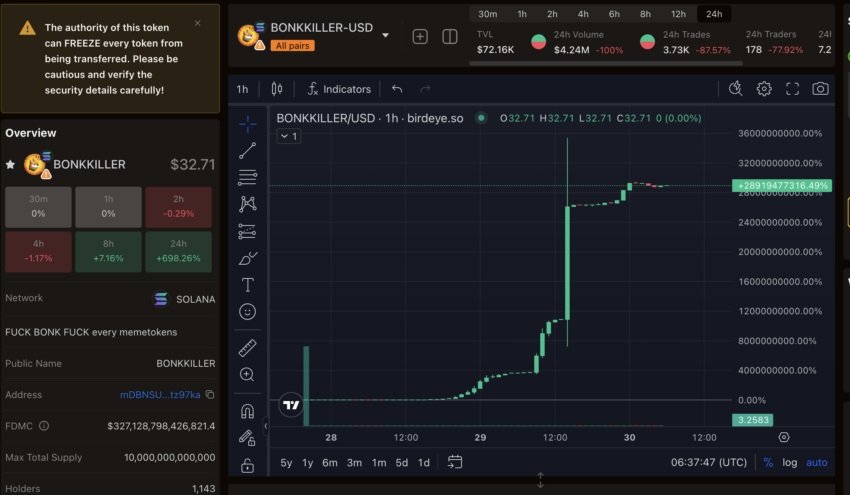The cryptocurrency world is known for its volatility, innovation, and occasional brushes with the absurd. In April 2024, the market witnessed one such incident with the rise and fall of Bonkkiller, a meme coin that briefly achieved an astronomical market capitalization before revealing itself as a cleverly disguised scam. This article delves into the Bonkkiller saga, exploring its meteoric rise, the red flags that exposed its true nature, and the lessons it offers for cryptocurrency investors.
A Meme Coin with Outlandish Claims
Bonkkiller emerged on the Solana blockchain in April 2024. Like many meme coins, it lacked real-world utility or a clear purpose beyond speculation. However, what set Bonkkiller apart was its outlandish claim to fame – a market capitalization exceeding $328 trillion. This figure dwarfed the combined GDP of all nations, raising eyebrows within the cryptocurrency community.
Despite the implausibility, Bonkkiller garnered some initial interest. The meme coin attracted over 1,000 investors, some likely lured by the prospect of massive returns. The trading volume within the first 24 hours reached around $4.6 million, indicating a flurry of activity.
The Scam Unravels: Honeypot Mechanics
While the initial excitement may have seemed promising, cracks soon began to appear in Bonkkiller’s facade. The key giveaway was the inability of investors to sell their holdings. The developer had implemented a “freeze authority” feature within the smart contract, essentially locking investors’ funds. This raised a red flag, as legitimate cryptocurrencies allow for free buying and selling on decentralized exchanges.
Further investigation revealed Bonkkiller to be a classic honeypot scam. Honeypot schemes are designed to attract investors with the promise of high returns but restrict their ability to withdraw their funds. In Bonkkiller’s case, the developer likely held a significant portion of the tokens, artificially inflating the market cap. Once enough investors were trapped, the value inevitably plummeted, leaving them with worthless holdings.
The Aftermath: A Stark Reminder for Investors
The Bonkkiller saga serves as a stark reminder for cryptocurrency investors to be cautious and conduct thorough research before investing. Here are some key takeaways:
- Scrutinize Market Capitalization: A market cap significantly exceeding established cryptocurrencies like Bitcoin is a major red flag.
- Beware of Unrealistic Promises: If a meme coin promises astronomical returns with no underlying utility, it’s likely too good to be true.
- Investigate Smart Contract Features: Understand the functionality of the smart contract, especially regarding token transferability.
- Diversification is Key: Don’t put all your eggs in one basket. Spread your investments across various established cryptocurrencies.
Regulatory Landscape and the Future of Meme Coins
The Bonkkiller incident highlights the need for a more robust regulatory framework within the cryptocurrency space. While complete regulation might stifle innovation, some measures could help protect investors from scams. These could include mandatory smart contract audits and disclosure requirements for meme coin creators.
The future of meme coins remains uncertain. While some may evolve into legitimate projects, others will likely continue to exploit loopholes and target unsuspecting investors. The onus lies on investors to be vigilant and conduct proper due diligence before investing in these often-risky ventures.
Beyond Bonkkiller: The Broader Meme Coin Phenomenon
Meme coins, with their lighthearted branding and association with internet culture, have become a significant part of the cryptocurrency landscape. However, their inherent lack of utility and susceptibility to manipulation raise concerns.
The success of established meme coins like Dogecoin has fueled a wave of copycats, many with questionable value propositions. Investors should be wary of meme coins solely driven by hype and social media trends.
While some meme coins may eventually find legitimate use cases, for now, the majority remain speculative assets with a high risk of failure. Investors should approach them with caution and prioritize well-established cryptocurrencies with strong fundamentals.
The Bonkkiller saga serves as a cautionary tale, reminding us of the ever-present risk of scams within the cryptocurrency space. By staying informed, conducting thorough research, and prioritizing established projects, investors can navigate this exciting yet volatile market with a greater degree of confidence.

